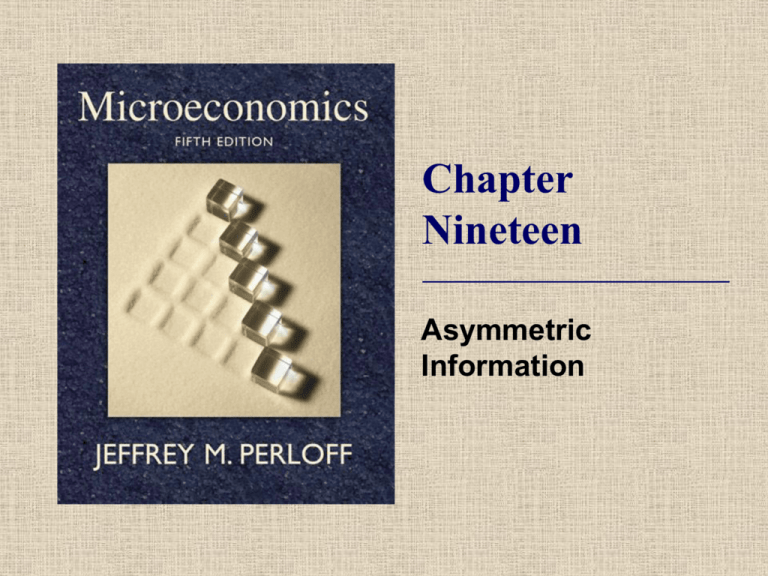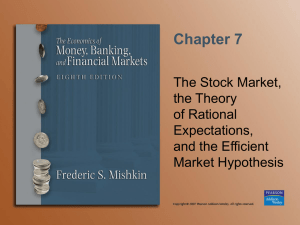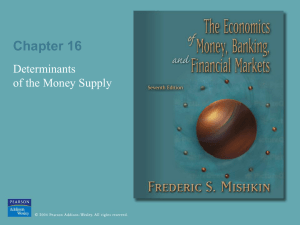
Chapter
Nineteen
Asymmetric
Information
Topics
Problems Due to Asymmetric
Information.
Responses to Adverse Selection.
How Ignorance About Quality Drives
Out High-Quality Goods.
Price Discrimination Due to False
Beliefs About Quality.
Market Power from Price Ignorance.
Problems Arising from Ignorance
When Hiring.
© 2009 Pearson Addison-Wesley. All rights reserved.
19-2
Problems Due to Asymmetric
Information
adverse selection - opportunism
characterized by an informed person’s
benefiting from trading or otherwise
contracting with a less-informed person
who does not know about an
unobserved characteristic of the
informed person
© 2009 Pearson Addison-Wesley. All rights reserved.
19-3
Problems Due to Asymmetric
Information
moral hazard - opportunism
characterized by an informed person’s
taking advantage of a less informed
person through an unobserved action
© 2009 Pearson Addison-Wesley. All rights reserved.
19-4
Controlling Opportunistic Behavior
Through Universal Coverage
Adverse selection can be prevented if
informed people have no choice.
A government can avoid adverse selection
by providing insurance to everyone or by
mandating that everyone buy insurance.
© 2009 Pearson Addison-Wesley. All rights reserved.
19-5
Equalizing Information
screening - an action taken by an
uninformed person to determine the
information possessed by informed
people.
signaling - an action taken by an
informed person to send information to
an uninformed person.
© 2009 Pearson Addison-Wesley. All rights reserved.
19-6
Lemons Market with Fixed Quality
When buyers cannot judge a product’s
quality before purchasing it, low-quality
products—lemons—may drive highquality products out of the market.
© 2009 Pearson Addison-Wesley. All rights reserved.
19-7
Lemons Market with Fixed Quality
Cars that appear to be identical on the
outside often differ substantially in the
number of repairs they will need.
Some cars —lemons— have a variety of
insidious problems that become apparent to
the owner only after the car has been driven
for a while.
The seller of a used car knows from
experience whether the car is a lemon.
We assume that the seller cannot alter the
quality of the used car
© 2009 Pearson Addison-Wesley. All rights reserved.
19-8
Lemons Market with Fixed Quality
Suppose that there are many potential
buyers for used cars.
All are willing to pay $1,000 for a lemon and
$2,000 for a good used car.
© 2009 Pearson Addison-Wesley. All rights reserved.
19-9
Figure 19.1 Markets for Lemons and
Good Cars
(b) Market for Good Cars
Price of a lemon, $
Price of a good ca r, $
(a) Market for Lemons
2,000
DG
DL
1,000
0
0
Lemons per year
© 2009 Pearson Addison-Wesley. All rights reserved.
Good cars per year
19-10
Lemons Market with Fixed Quality
1,000 owners of lemons and 1,000 owners
of good cars are willing to sell.
The reservation price of owners of lemons—
the lowest price at which they will sell their
cars—is $750.
The reservation price of owners of highquality used cars is v, which is less than
$2,000.
© 2009 Pearson Addison-Wesley. All rights reserved.
19-11
Figure 19.1 Markets for Lemons and
Good Cars
1,500
(b) Market for Good Cars
Price of a good ca r, $
Price of a lemon, $
(a) Market for Lemons
SL
f
D*
1,750
1,000
S2
1,500
1,250
e
E
2,000
F
DG
D*
S1
DL
750
0
1,000
Lemons per year
© 2009 Pearson Addison-Wesley. All rights reserved.
0
1,000
Good cars per year
19-12
Lemons Market with Fixed Quality
If both sellers and buyers know the quality
of all the used cars before any sales take
place, all the cars are sold, and good cars
sell for more than lemons.
This market is efficient because the goods
go to the people who value them the most.
All the cars are sold if everyone has the
same information
© 2009 Pearson Addison-Wesley. All rights reserved.
19-13
Lemons Market with Fixed Quality
The amount of information they have
affects the price at which the cars sell.
If no one can tell a lemon from a good car at
the time of purchase, both types of cars sell
for the same price.
© 2009 Pearson Addison-Wesley. All rights reserved.
19-14
Lemons Market with Fixed Quality
Suppose that everyone is risk neutral and
no one can identify the lemons: Buyers
and sellers are equally ignorant.
A buyer has an equal chance of buying a
lemon or a good car.
The expected value of a used car is
© 2009 Pearson Addison-Wesley. All rights reserved.
19-15
Lemons Market with Fixed Quality
This market is efficient because the cars
go to people who value them more than
their original owners.
Sellers of good-quality cars are implicitly
subsidizing sellers of lemons.
© 2009 Pearson Addison-Wesley. All rights reserved.
19-16
Asymmetric Information.
If sellers know the quality but buyers do
not, this market may be inefficient:
The better-quality cars may not be sold
even though buyers value good cars more
than sellers do.
The equilibrium in this market depends on
whether the value that the owners of good
cars place on their cars, v, is greater or less
than the expected value of buyers, $1,500.
© 2009 Pearson Addison-Wesley. All rights reserved.
19-17
Asymmetric Information.
There are two possible equilibria:
All cars sell at the average price, or
only lemons sell for a price equal to the
value that buyers place on lemons.
© 2009 Pearson Addison-Wesley. All rights reserved.
19-18
Figure 19.1 Markets for Lemons and
Good Cars
1,500
(b) Market for Good Cars
SL
f
D*
Price of a good ca r, $
Price of a lemon, $
(a) Market for Lemons
1,750
1,000
S2
1,500
1,250
e
E
2,000
F
DG
D*
S1
DL
750
0
1,000
Lemons per year
© 2009 Pearson Addison-Wesley. All rights reserved.
0
1,000
Good cars per year
19-19
Asymmetric Information.
Consequently, asymmetric information
does not cause an efficiency problem,
but it does have equity implications.
Sellers of lemons benefit and sellers of
good cars suffer from consumers’ inability
to distinguish quality.
© 2009 Pearson Addison-Wesley. All rights reserved.
19-20
Asymmetric Information.
Now suppose that the sellers of good cars
place a value of v = $1,750 on their cars and
thus are unwilling to sell them for $1,500.
As a result, the lemons drive good cars out of the
market.
Buyers realize that, at any price less than $1,750,
they can buy only lemons.
Consequently, in equilibrium, the 1,000 lemons sell
for the expected (and actual) price of $1,000, and
no good cars change hands.
© 2009 Pearson Addison-Wesley. All rights reserved.
19-21
Asymmetric Information.
This equilibrium is inefficient because
high-quality cars remain in the hands of
people who value them less than
potential buyers do.
© 2009 Pearson Addison-Wesley. All rights reserved.
19-22
Solved Problem 19.1
Suppose that everyone in our used-car
example is risk neutral, potential car buyers
value lemons at $1,000 and good used cars at
$2,000, the reservation price of lemon owners
is $750, and the reservation price of owners of
high-quality used cars is $1,750.The share of
current owners who have lemons is θ [in our
previous example, the share was θ = 1 2 =
1,000/(1,000 + 1,000)]. For what values of θ
do all the potential sellers sell their used cars?
Describe the equilibrium.
© 2009 Pearson Addison-Wesley. All rights reserved.
19-23
Lemons Market with Variable Quality
Suppose that it costs $10 to produce a lowquality book bag and $20 to produce a highquality bag,
consumers cannot distinguish between the
products before purchase,
there are no repeat purchases, and
consumers value the bags at their cost of
production.
The five firms in the market produce 100 bags
each.
A firm produces only high-quality or only lowquality bags.
© 2009 Pearson Addison-Wesley. All rights reserved.
19-24
Lemons Market with Variable Quality
If one firm makes a high-quality bag and
all the others make low-quality bags, the
expected value per bag to consumers is
Thus, if one firm raises the quality of its
product, all firms benefit because the bags
sell for $12 instead of $10.
© 2009 Pearson Addison-Wesley. All rights reserved.
19-25
Lemons Market with Variable Quality
Because the high-quality firm incurs all
the expenses of raising quality, $10
extra per bag, and reaps only a fraction,
$2, of the benefits, it opts not to produce
the high-quality bags.
Therefore, due to asymmetric
information, the firms do not produce
high-quality goods even though
consumers are willing to pay for the
extra quality.
© 2009 Pearson Addison-Wesley. All rights reserved.
19-26
Limiting Lemons
Laws to Prevent Opportunism.
Consumer Screening.
Third-Party Comparisons.
Standards and Certification.
Signaling by Firms.
© 2009 Pearson Addison-Wesley. All rights reserved.
19-27
Price Discrimination Due to False
Beliefs About Quality
One way in which firms confuse
consumers is to create noise by selling
virtually the same product under various
brand names.
© 2009 Pearson Addison-Wesley. All rights reserved.
19-28
Market Power from Price
Ignorance
Suppose that many stores in a town sell
the same good.
If consumers have full information about
prices, all stores charge the full-information
competitive price, p*.
If one store were to raise its price above p*,
the store would lose all its business.
Each store faces a residual demand curve
that is horizontal at the going market price
and has no market power.
© 2009 Pearson Addison-Wesley. All rights reserved.
19-29
Market Power from Price
Ignorance
If consumers have limited information
about the price that firms charge for a
product, one store can charge more
than others and not lose all its
customers.
Customers who do not know that the
product is available for less elsewhere keep
buying from the high-price store.
Thus, each store faces a downward-sloping
residual demand curve and has some
market power.
© 2009 Pearson Addison-Wesley. All rights reserved.
19-30
Tourist-Trap Model
You arrive in a small town near the site of the
discovery of gold in California. Souvenir shops crowd
the street. Wandering by one of these stores, you see
that it sells the town’s distinctive snowy: a plastic ball
filled with water and imitation snow featuring a model
of the Donner Party. You instantly decide that you
must buy at least one of these tasteful mementos—
perhaps more if the price is low enough. Your bus will
leave very soon, so you can’t check the price at each
shop to find the lowest price. Moreover, determining
which shop has the lowest price won’t be useful to
you in the future because you do not intend to return
anytime soon.
© 2009 Pearson Addison-Wesley. All rights reserved.
19-31
Tourist-Trap Model
Let’s assume that you and other tourists
have a guidebook that reports how
many souvenir shops charge each
possible price for the snowy, but the
guidebook does not state the price at
any particular shop. There are many
tourists in your position, each with an
identical demand function.
© 2009 Pearson Addison-Wesley. All rights reserved.
19-32
Tourist-Trap Model
It costs each tourist c in time and
expenses to visit a shop to check the
price or buy a snowy.
Thus, if the price is p, the cost of buying a
snowy at the first shop you visit is p + c.
If you go to two souvenir shops before
buying at the second shop, the cost of the
snowy is p + 2c.
© 2009 Pearson Addison-Wesley. All rights reserved.
19-33
When Price Is Not Competitive.
Will all souvenir shops charge the same
price?
If so, what price will they charge?
© 2009 Pearson Addison-Wesley. All rights reserved.
19-34
When Price Is Not Competitive.
If all other shops charge p*, a firm can
profitably charge p1 = p* + ε,
where ε, a small positive number, is the
shop’s price markup.
If consumers have limited information
about price, an equilibrium in which all
firms charge the full-information,
competitive price is impossible.
© 2009 Pearson Addison-Wesley. All rights reserved.
19-35
Monopoly Price.
Can there be an equilibrium in which all
stores charge the same price and that
price is higher than the competitive
price?
The monopoly price may be an equilibrium
price.
© 2009 Pearson Addison-Wesley. All rights reserved.
19-36
Monopoly Price.
When consumers have asymmetric
information and when search costs and
the number of firms are large, the only
possible single-price equilibrium is at the
monopoly price.
© 2009 Pearson Addison-Wesley. All rights reserved.
19-37
Solved Problem 19.2
Initially, there are many souvenir shops,
each of which charges pm (because
consumers do not know the shops’
prices), and buyers’ search costs are c.
If the government pays for half of
consumers’ search costs, can there be a
single-price equilibrium at a price less
than pm?
© 2009 Pearson Addison-Wesley. All rights reserved.
19-38
Information About Employment Risks
Firms typically have more information
than workers about job safety.
This asymmetric information may lead to
less than optimal levels of safety
© 2009 Pearson Addison-Wesley. All rights reserved.
19-39
Information About Employment Risks
Each firm must consider how safe to
make its plant.
Extra safety is costly.
Safety investments by one firm provide
an externality to other firms:
That firm’s lower incidence of accidents
reduces the wage that all firms in the
industry must pay.
Because each firm bears the full cost of its
safety investments but derives only some of
the benefits, the firms underinvest in safety.
© 2009 Pearson Addison-Wesley. All rights reserved.
19-40
Table 19.1 Safety Investment Game
© 2009 Pearson Addison-Wesley. All rights reserved.
19-41
Cheap Talk
When an informed person voluntarily
provides information to an uninformed
person, the informed person engages in:
cheap talk - unsubstantiated claims or
statements
© 2009 Pearson Addison-Wesley. All rights reserved.
19-42
Cheap Talk
Suppose that a firm plans to hire Cyndi
to do one of two jobs.
The demanding job requires someone with
high ability.
The undemanding job can be done better
by someone of low ability because the job
bores more able people, who then perform
poorly.
© 2009 Pearson Addison-Wesley. All rights reserved.
19-43
Table 19.2 Employee-Employer Payoffs
© 2009 Pearson Addison-Wesley. All rights reserved.
19-44
Cheap Talk
The firm’s expected payoff is
1 1
1 4 2.5
2 2
if it gives her the undemanding job and
1 1
2 1 1.5
2 2
© 2009 Pearson Addison-Wesley. All rights reserved.
19-45
Education as a Signal
If high-ability people are more likely to
go to college than low-ability people,
schooling signals ability to employers
© 2009 Pearson Addison-Wesley. All rights reserved.
19-46
Education as a Signal
Extreme assumptions that
graduating from an appropriate school serves as
the signal and
that schooling provides no training that is useful to
firms
High-ability workers are θ share of the
workforce, and low-ability workers are 1 − θ
share.
The value of output that a high-ability worker
produces for a firm is worth wh, and that of a
low-ability worker is wl (over their careers).
© 2009 Pearson Addison-Wesley. All rights reserved.
19-47
Education as a Signal
pooling equilibrium - an equilibrium in
which dissimilar people are treated (paid)
alike or behave alike.
Employers pay all workers the average
wage:
w wh 1 wl
© 2009 Pearson Addison-Wesley. All rights reserved.
19-48
Education as a Signal
We assume that
high-ability individuals can get a degree by
spending c to attend a school and
that low-ability people cannot graduate from
the school
© 2009 Pearson Addison-Wesley. All rights reserved.
19-49
Education as a Signal
separating equilibrium - an equilibrium
in which one type of people takes
actions (such as sending a signal) that
allows them to be differentiated from
other types of people
© 2009 Pearson Addison-Wesley. All rights reserved.
19-50
Education as a Signal
In a separating equilibrium,
high-ability people pay c to get a degree
and are employed at a wage of wh,
while low-ability individuals do not get a
degree and work for a wage of wl.
© 2009 Pearson Addison-Wesley. All rights reserved.
19-51
Education as a Signal
Rearranging terms in the previous
expression, we find that a high-ability
person chooses to get a degree if
wh − wl > c.
© 2009 Pearson Addison-Wesley. All rights reserved.
19-52
Pooling Equilibrium.
In a pooling equilibrium, all workers are paid
the average wage.
It does not pay for the high-ability person to
graduate if the benefit from graduating, the
extra pay is less than the cost of schooling:
wh w c
© 2009 Pearson Addison-Wesley. All rights reserved.
19-53
Solved Problem 19.3
For what values of θ is a pooling
equilibrium possible in general? In
particular, if c = $15,000, wh = $40,000, and
wl = $20,000, for what values of θ is a
pooling equilibrium possible?
© 2009 Pearson Addison-Wesley. All rights reserved.
19-54
Unique or Multiple Equilibria.
Depending on differences in abilities, the
cost of schooling, and the share of highability workers, only one type of
equilibrium may be possible or both may
be possible.
© 2009 Pearson Addison-Wesley. All rights reserved.
19-55
Figure 19.2 Pooling and
Separating Equilibria
© 2009 Pearson Addison-Wesley. All rights reserved.
19-56
Efficiency.
In our example of a separating
equilibrium, high-ability people get an
otherwise useless education solely to
show that they differ from low-ability
people.
Signaling changes the distribution of
wages:
Instead of everyone getting the average
wage, high-ability workers receive more
pay than low-ability workers.
© 2009 Pearson Addison-Wesley. All rights reserved.
19-57
Figure 19.2 Pooling and
Separating Equilibria
© 2009 Pearson Addison-Wesley. All rights reserved.
19-58
Efficiency.
Total social output falls with signaling if
signaling is socially unproductive but
may rise with signaling if signaling also
raises productivity or serves some other
desirable purpose.
© 2009 Pearson Addison-Wesley. All rights reserved.
19-59
Screening in Hiring
Firms screen prospective workers in
many ways.
Interviews and Tests.
Statistical Discrimination
© 2009 Pearson Addison-Wesley. All rights reserved.
19-60
Figure 19.3
Statistical Discrimination
© 2009 Pearson Addison-Wesley. All rights reserved.
19-61







